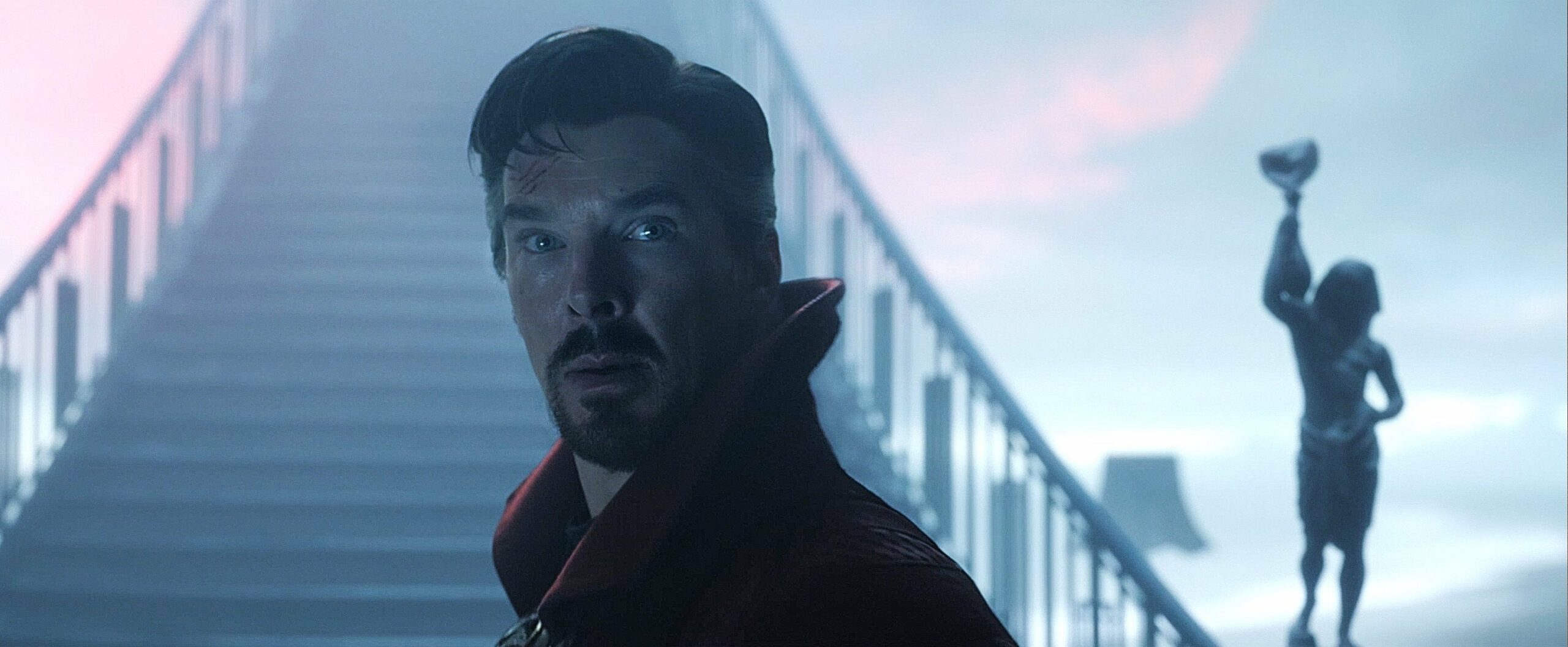
Doctor Strange in the Multiverse of Madness is a lot of information crammed into very little story. Doctor Strange and Wanda Maximoff are sad because they are alone. Their sadness sends them into the multiverse in hopes of finding solace for their grief and something new to live for. It is another variation on the multiverse concept echoing through our blockbusters of late. It’s been done better with better characters, though, as usual, MCU properties rarely feel like a waste of time. Doctor Strange in the Multiverse of Madness is no different. You’ll want to have watched WandaVision and Loki and maybe even What If…? before watching this movie. That’s a tall order, I know, but I can’t imagine it making any sense otherwise.
There is a character in Doctor Strange in the Multiverse of Madness that destroys others by speaking to them. Sound waves emanate from his mouth and disintegrate his target. This ability is used once touchingly and another time to gruesome comic effect. I kind of felt like one of his victims as Doctor Strange in the Multiverse of Madness assaulted me with call-outs to things unfamiliar to me. I used to follow every trip to the theater to see a new MCU movie with a trip to Wikipedia to look up all the stuff I didn’t understand. Fourteen years, twenty-three films, and sixteen TV shows into the MCU, and I hardly even bother anymore. The narrative world of these Marvel movies is too vast.
Works of art certainly don’t have to be comprehensible within themselves. It is highly desirable for a work of art to prompt the viewer/listener/reader to go beyond the artifact and to explore the world the artifact is a reflection upon. But there’s a big difference between movies that send me reeling into ancient scriptures and contemporary quantum theory, to mythic sagas and Shakespeare, or to the current capacities of home surveillance technology and the tradition of 1970s paranoid thrillers—to reference a few recent movie-inspired intellectual quests—and a movie that refers me back to its parent company’s website where I can purchase a membership that will enable me to “keep track of all my favorite characters” for $69/year.
It would help if Doctor Strange was a more interesting character. The visual flourishes his ability set makes possible as he trips through various realities are neat, but that’s only a few moments of his movies. Mostly he lacks desires and, therefore, personality.
Director Sam Raimi adds a few heaping cups of horror to the mix, and those sequences are fun too, mainly because they feel slightly different than what we’ve seen before in this series of films. Raimi leans a bit too much on references to his own previous films. My favorite is a few references in an early scene to the best live-action superhero movie ever made, Raimi’s Spider-Man 2. The scene involves a wedding and an octopus-like creature. But since trite references are the name of the game here, I guess those easy visual cues are fine. A director with a less well-known back catalog of films wouldn’t have been able to reference himself as blatantly.
Back in 2012, things were simple. There was a couple of Iron Man movies, a Captain America movie, a Thor movie, and then BOOM! The Avengers, a team-up movie that felt like it was one of the biggest and most exciting movies of my lifetime. Now there is certainly a lot more here. Doctor Strange in the Multiverse of Madness is “bigger” by every measure except in the amount of excitement it inspires in me. Watching it is fine, but thinking about it feels mostly like a chore.
Doctor Strange in the Multiverse of Madness is a lot of information crammed into very little story. Doctor Strange and Wanda Maximoff are sad because they are alone. Their sadness sends them into the multiverse in hopes of finding solace for their grief and something new to live for. It is another variation on the multiverse concept echoing through our blockbusters of late. It’s been done better with better characters, though, as usual, MCU properties rarely feel like a waste of time. Doctor Strange in the Multiverse of Madness is no different. You’ll want to have watched WandaVision and Loki and maybe even What If…? before watching this movie. That’s a tall order, I know, but I can’t imagine it making any sense otherwise.
There is a character in Doctor Strange in the Multiverse of Madness that destroys others by speaking to them. Sound waves emanate from his mouth and disintegrate his target. This ability is used once touchingly and another time to gruesome comic effect. I kind of felt like one of his victims as Doctor Strange in the Multiverse of Madness assaulted me with call-outs to things unfamiliar to me. I used to follow every trip to the theater to see a new MCU movie with a trip to Wikipedia to look up all the stuff I didn’t understand. Fourteen years, twenty-three films, and sixteen TV shows into the MCU, and I hardly even bother anymore. The narrative world of these Marvel movies is too vast.
Works of art certainly don’t have to be comprehensible within themselves. It is highly desirable for a work of art to prompt the viewer/listener/reader to go beyond the artifact and to explore the world the artifact is a reflection upon. But there’s a big difference between movies that send me reeling into ancient scriptures and contemporary quantum theory, to mythic sagas and Shakespeare, or to the current capacities of home surveillance technology and the tradition of 1970s paranoid thrillers—to reference a few recent movie-inspired intellectual quests—and a movie that refers me back to its parent company’s website where I can purchase a membership that will enable me to “keep track of all my favorite characters” for $69/year.
It would help if Doctor Strange was a more interesting character. The visual flourishes his ability set makes possible as he trips through various realities are neat, but that’s only a few moments of his movies. Mostly he lacks desires and, therefore, personality.
Director Sam Raimi adds a few heaping cups of horror to the mix, and those sequences are fun too, mainly because they feel slightly different than what we’ve seen before in this series of films. Raimi leans a bit too much on references to his own previous films. My favorite is a few references in an early scene to the best live-action superhero movie ever made, Raimi’s Spider-Man 2. The scene involves a wedding and an octopus-like creature. But since trite references are the name of the game here, I guess those easy visual cues are fine. A director with a less well-known back catalog of films wouldn’t have been able to reference himself as blatantly.
Back in 2012, things were simple. There was a couple of Iron Man movies, a Captain America movie, a Thor movie, and then BOOM! The Avengers, a team-up movie that felt like it was one of the biggest and most exciting movies of my lifetime. Now there is certainly a lot more here. Doctor Strange in the Multiverse of Madness is “bigger” by every measure except in the amount of excitement it inspires in me. Watching it is fine, but thinking about it feels mostly like a chore.

Elijah Davidson is Co-Director of Brehm Film and Senior Film Critic. Subscribe to his weekly email series that guides you through film history, Come & See, and find more of his work at elijahdavidson.com.
We see what we have the eyes of faith to see. The Northman lets us see with viking eyes for a couple of hours. I see, and I shudder.